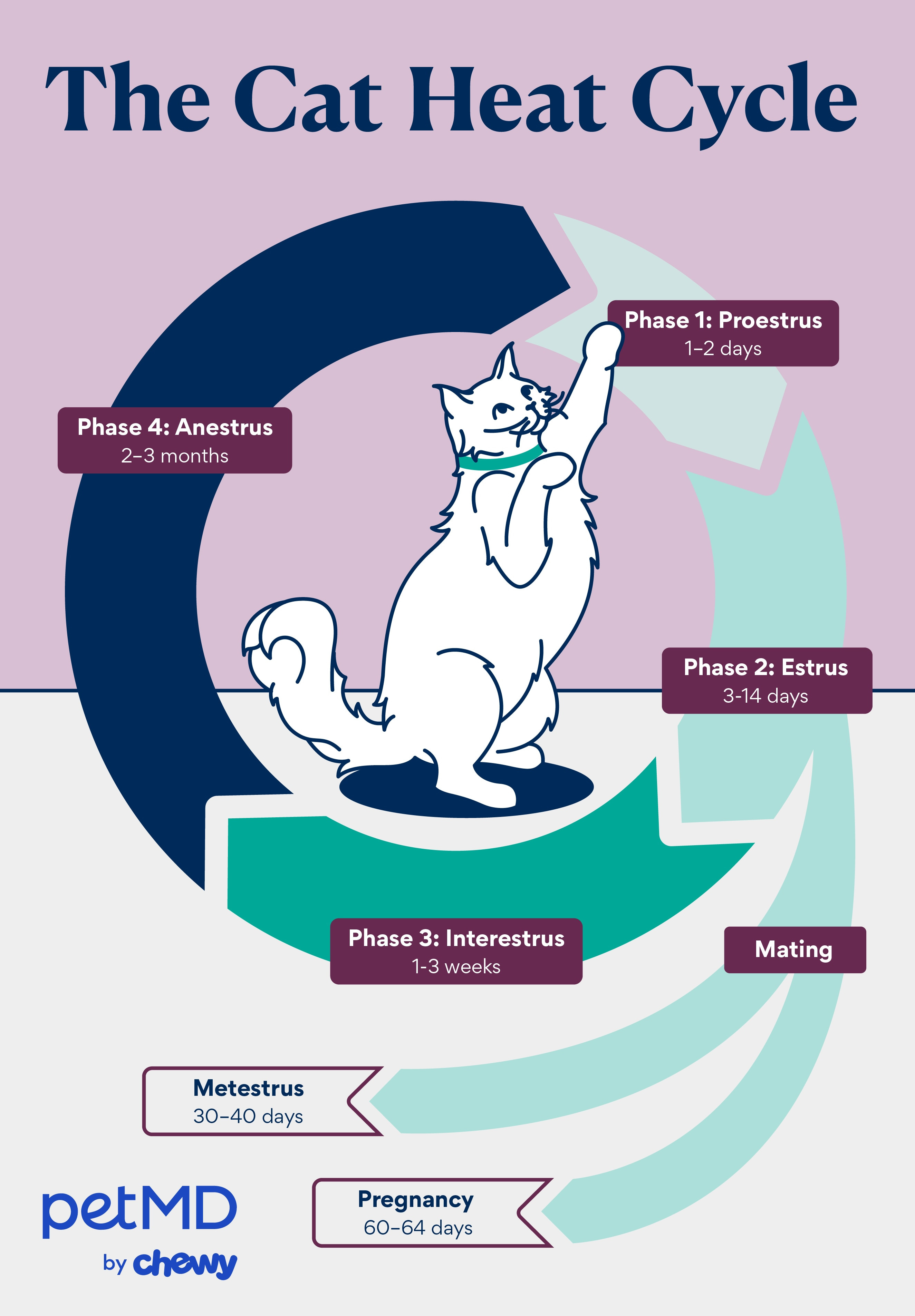To produce kittens, unspayed female cats, known as queens, experience a heat cycle, or estrous cycle. This cycle is significantly different from those of dogs and humans, making it essential for cat owners to understand the signs if they haven’t spayed their feline companion. If you’re wondering about your cat’s behavior and suspect she might be in heat, a key question you likely have is: How Long Does A Cat Remain In Heat? Let’s delve into the details of the feline estrous cycle to provide a comprehensive answer.
Decoding the Cat Heat Cycle: Stages and Duration
The cat heat cycle is not a continuous event but rather a series of distinct stages. Understanding these stages is crucial to grasping the overall duration of a cat’s heat and the behavioral changes you might observe. The cycle is comprised of four primary phases: proestrus, estrus, interestrus or metestrus, and anestrus. Each stage plays a unique role in the reproductive process and contributes to the total time a cat experiences heat-related symptoms.
Proestrus: The Prelude to Heat
The first stage is proestrus, marking the beginning of hormonal changes as estrogen levels start to rise in the queen’s body. This phase is typically short, lasting just one to two days. Interestingly, outward signs of proestrus are often subtle and may not be easily noticeable to cat owners. While male cats might sense hormonal shifts and show increased interest, the female cat will generally not be receptive to mating during proestrus. This initial stage is more of a preparatory phase, setting the stage for the more pronounced signs of heat to come.
Estrus: The Peak of “Heat”
Estrus is the stage most commonly recognized as “being in heat.” This is the period when a female cat is receptive to mating and exhibits the classic behavioral changes associated with heat. Estrus is characterized by a significant shift in the queen’s demeanor. She may become excessively affectionate, seeking attention from her human family and other pets. Vocalization becomes more frequent and intense, often manifesting as loud meowing or caterwauling, aimed at attracting male cats. Restlessness is another hallmark, with cats in estrus often pacing and appearing agitated.
The duration of estrus is variable, typically lasting for about a week. However, it can range from as short as three days to as long as two weeks (14 days). This variability is influenced by individual cat factors and environmental conditions, particularly the presence of daylight. It’s during the estrus stage that mating will occur if the queen has access to a male cat.
 illustration depicting a cat
illustration depicting a cat
Interestrus or Metestrus: The Period Between Estrus Cycles
Following estrus, a cat enters a phase referred to as either interestrus or metestrus, depending on whether ovulation occurred. Cats are induced ovulators, meaning they typically only release eggs from their ovaries after mating.
- Metestrus: If a cat mates during estrus, ovulation is triggered, and the cycle enters metestrus. In this scenario, the queen’s body prepares for potential pregnancy. If fertilization does not occur, metestrus lasts for approximately 30 to 40 days. If pregnancy results, this phase transitions into a gestation period of about 60 to 64 days.
- Interestrus: If a cat in estrus does not mate and therefore does not ovulate, she will enter interestrus. This is a period of hormonal inactivity and a break from heat behaviors. Interestrus typically lasts for a shorter duration, ranging from one to three weeks. After interestrus, if environmental conditions are still conducive (e.g., sufficient daylight), the queen will cycle back into proestrus, restarting the heat cycle.
Anestrus: The Inactive Phase
Anestrus is the stage of reproductive inactivity. Cats are seasonally polyestrous, meaning their heat cycles are influenced by the seasons and the length of daylight hours. Anestrus occurs during the shorter daylight months, typically in the late fall and winter. During anestrus, there is minimal hormonal activity related to reproduction, and the queen will not experience heat cycles. This period of dormancy usually lasts for two to three months, providing a break between active cycling periods. As daylight hours increase in late winter and early spring, cats will begin to cycle again, starting with proestrus.
How Often Do Cats Go into Heat and Does it Affect Duration?
The frequency of cat heat cycles is strongly linked to seasonal changes and daylight hours. Cats are “long-day breeders,” meaning their reproductive cycles are most active when daylight hours are longer. This is why heat cycles are more frequent in the spring and summer months, typically starting in late winter or early spring (February to April) and continuing through fall (October or November).
During peak breeding season, a cat may cycle repeatedly, going through estrus and interestrus phases multiple times. If a cat does not become pregnant, she can go into heat again every 2 to 3 weeks during the breeding season. This frequent cycling means that an unspayed cat can spend a significant portion of the spring, summer, and early fall in heat.
The duration of each estrus cycle can be somewhat influenced by whether ovulation occurs. If a cat mates and ovulates, the subsequent metestrus phase provides a longer break before the next cycle might begin (if pregnancy doesn’t occur). However, if a cat does not mate, the shorter interestrus periods lead to more frequent returns to estrus. Therefore, while the typical estrus phase lasts about a week, the overall experience of being “in heat” can seem almost continuous during breeding season due to these repeated cycles.
Recognizing the Signs: Is My Cat in Heat?
Unlike dogs, cats do not exhibit vaginal bleeding during their heat cycle, making the signs primarily behavioral. Recognizing these behavioral changes is key to knowing when your cat is in heat. Common signs include:
- Increased Affection: Cats in heat often become unusually affectionate, rubbing against furniture, legs, and seeking more attention than usual. They may become clingy and demand petting.
- Excessive Vocalization: One of the most noticeable signs is increased vocalization. This can range from constant meowing to loud, drawn-out yowling or caterwauling, as the cat attempts to attract male cats.
- Restlessness and Agitation: Cats in heat may appear restless, pacing around the house, and seeming unable to settle down.
- Posturing and Lordosis: A characteristic posture of a cat in heat is the lordosis position. This involves crouching low in the front with her forelegs bent, while raising her hindquarters and treading her back paws. If you stroke her back, she may intensify this posture.
- Spraying or Urinating Outside the Litter Box: While less common than other signs, some cats in heat may start spraying urine or urinating outside their litter box as a way to mark territory and attract males.
- Reduced Appetite: Some cats may experience a decrease in appetite while in heat.
It’s important to note that while these behavioral changes are typical of a cat in heat, any sudden or significant changes in your cat’s behavior should prompt a consultation with your veterinarian to rule out any underlying health issues.
Managing a Cat in Heat and Preventing Future Cycles
Dealing with a cat in heat can be challenging due to the behavioral changes. To prevent unwanted pregnancies, it’s crucial to keep unspayed female cats indoors during their heat cycles to avoid contact with male cats. Beyond this, there are no specific necessary lifestyle changes for a cat in heat, but understanding the cycle helps owners provide appropriate care and manage their cat’s behavior.
For long-term management and to prevent heat cycles altogether, spaying is the most effective and recommended solution.
Spaying: Eliminating Heat Cycles and Providing Health Benefits
Spaying, or ovariohysterectomy, is the surgical removal of the uterus and ovaries. This procedure completely eliminates heat cycles and the associated behaviors. Unless you are a responsible breeder and intend for your cat to produce kittens, spaying is highly recommended for several reasons:
- Prevents Unwanted Pregnancies: Spaying eliminates the risk of unplanned litters, contributing to the control of cat overpopulation.
- Eliminates Heat Cycle Behaviors: Spaying resolves the often disruptive and stressful behaviors associated with heat cycles, such as excessive vocalization and restlessness.
- Reduces Risk of Health Problems: Spaying significantly reduces the risk of several serious health conditions, including pyometra (uterine infection), mammary cancer, and ovarian cancer. These conditions are more common in unspayed female cats.
Alt text: A veterinarian performing a spay surgery on a cat, illustrating the surgical procedure of ovariohysterectomy to prevent heat cycles and ensure long-term health.
Veterinarians generally recommend spaying kittens at around 5 to 6 months of age, before they experience their first heat cycle. However, cats can be spayed at any age. Even if your cat has already had heat cycles, spaying is still beneficial for preventing future cycles and reducing health risks.
Consult your veterinarian to discuss spaying and determine the best time to schedule the procedure for your cat.
Key Takeaways: How Long Does a Cat’s Heat Last?
In summary, when considering “how long does a cat stay in heat,” it’s important to remember:
- The estrus stage, or the period of active “heat” behavior and receptivity to mating, typically lasts about one week, but can range from 3 to 14 days.
- The entire heat cycle is a series of stages, including proestrus, estrus, interestrus/metestrus, and anestrus.
- Cats are seasonally polyestrous and cycle repeatedly during breeding season (spring to fall) if they are not spayed and do not become pregnant.
- Unspayed cats can go into heat every 2 to 3 weeks during the breeding season, meaning they may seem to be almost constantly in heat during these months.
- Spaying is the only way to permanently prevent heat cycles and is highly recommended for the health and well-being of female cats not intended for breeding.
Understanding the feline estrous cycle and the duration of heat is essential for responsible cat ownership. If you have any concerns about your cat’s reproductive health or behavior, always consult with your veterinarian for personalized advice and care.

